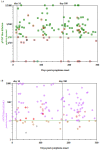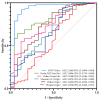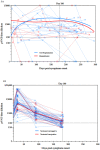Dynamics of Neutralizing Antibody Responses Following Natural SARS-CoV-2 Infection and Correlation with Commercial Serologic Tests. A Reappraisal and Indirect Comparison with Vaccinated Subjects
- PMID: 34835135
- PMCID: PMC8621742
- DOI: 10.3390/v13112329
Dynamics of Neutralizing Antibody Responses Following Natural SARS-CoV-2 Infection and Correlation with Commercial Serologic Tests. A Reappraisal and Indirect Comparison with Vaccinated Subjects
Abstract
Neutralising antibodies (NAbs) represent the real source of protection against SARS-CoV-2 infections by preventing the virus from entering target cells. The gold standard in the detection of these antibodies is the plaque reduction neutralization test (PRNT). As these experiments must be done in a very secure environment, other techniques based on pseudoviruses: pseudovirus neutralization test (pVNT) or surrogate virus neutralization test (sVNT) have been developed. Binding assays, on the other hand, measure total antibodies or IgG, IgM, and IgA directed against one epitope of the SARS-CoV-2, independently of their neutralizing capacity. The aim of this study is to compare the performance of six commercial binding assays to the pVNT and sVNT. In this study, we used blood samples from a cohort of 62 RT-PCR confirmed COVID-19 patients. Based on the results of the neutralizing assays, adapted cut-offs for the binding assays were calculated. The use of these adapted cut-offs does not permit to improve the accuracy of the serological assays and we did not find an adapted cut-off able to improve the capacity of these tests to detect NAbs. For a part of the population, a longitudinal follow-up with at least two samples for the same patient was performed. From day 14 to day 291, more than 75% of the samples were positive for NAbs (n = 87/110, 79.1%). Interestingly, 6 months post symptoms onset, the majority of the samples (N = 44/52, 84.6%) were still positive for NAbs. This is in sharp contrast with the results we obtained 6 months post-vaccination in our cohort of healthcare workers who have received the two-dose regimens of BNT162b2. In this cohort of vaccinated subjects, 43% (n = 25/58) of the participants no longer exhibit NAbs activity 180 days after the administration of the first dose of BNT162b2.
Keywords: COVID-19; SARS-CoV-2; neutralizing antibody.
Conflict of interest statement
The authors declare no conflict of interest.
Figures




Similar articles
-
Neutralizing Antibodies in COVID-19 Patients and Vaccine Recipients after Two Doses of BNT162b2.Viruses. 2021 Jul 14;13(7):1364. doi: 10.3390/v13071364. Viruses. 2021. PMID: 34372570 Free PMC article.
-
BNT162b2 COVID-19 vaccine and correlates of humoral immune responses and dynamics: a prospective, single-centre, longitudinal cohort study in health-care workers.Lancet Respir Med. 2021 Sep;9(9):999-1009. doi: 10.1016/S2213-2600(21)00220-4. Epub 2021 Jul 2. Lancet Respir Med. 2021. PMID: 34224675 Free PMC article.
-
Kinetics and ability of binding antibody and surrogate virus neutralization tests to predict neutralizing antibodies against the SARS-CoV-2 Omicron variant following BNT162b2 booster administration.Clin Chem Lab Med. 2023 Apr 21;61(10):1875-1885. doi: 10.1515/cclm-2022-1258. Print 2023 Sep 26. Clin Chem Lab Med. 2023. PMID: 37078220
-
Recent Developments in SARS-CoV-2 Neutralizing Antibody Detection Methods.Curr Med Sci. 2021 Dec;41(6):1052-1064. doi: 10.1007/s11596-021-2470-7. Epub 2021 Dec 21. Curr Med Sci. 2021. PMID: 34935114 Free PMC article. Review.
-
Detecting SARS-CoV-2 neutralizing immunity: highlighting the potential of split nanoluciferase technology.J Mol Cell Biol. 2022 Aug 17;14(4):mjac023. doi: 10.1093/jmcb/mjac023. J Mol Cell Biol. 2022. PMID: 35416249 Free PMC article. Review.
Cited by
-
Detection of SARS-CoV-2 IgA and IgG in human milk and breastfeeding infant stool 6 months after maternal COVID-19 vaccination.Res Sq [Preprint]. 2022 Aug 19:rs.3.rs-1950944. doi: 10.21203/rs.3.rs-1950944/v1. Res Sq. 2022. Update in: J Perinatol. 2023 Jun;43(6):775-781. doi: 10.1038/s41372-022-01581-5. PMID: 36032985 Free PMC article. Updated. Preprint.
-
Evaluation of Neutralizing Capacity of Tixagevimab plus Cilgavimab (AZD7442) against Different SARS-CoV-2 Variants: A Case Report Study with Comparison to a Vaccinated Population.Case Rep Infect Dis. 2024 Aug 31;2024:9163490. doi: 10.1155/2024/9163490. eCollection 2024. Case Rep Infect Dis. 2024. PMID: 39246664 Free PMC article.
-
Evaluation of commercial Anti-SARS-CoV-2 neutralizing antibody assays in seropositive subjects.J Clin Virol. 2022 Jul;152:105169. doi: 10.1016/j.jcv.2022.105169. Epub 2022 Apr 27. J Clin Virol. 2022. PMID: 35568003 Free PMC article.
-
Lung Transplant Recipients Immunogenicity after Heterologous ChAdOx1 nCoV-19-BNT162b2 mRNA Vaccination.Viruses. 2022 Jul 2;14(7):1470. doi: 10.3390/v14071470. Viruses. 2022. PMID: 35891450 Free PMC article.
-
SARS-CoV-2-Neutralizing Antibody Response and Correlation of Two Serological Assays with Microneutralization.Vaccines (Basel). 2023 Mar 3;11(3):590. doi: 10.3390/vaccines11030590. Vaccines (Basel). 2023. PMID: 36992173 Free PMC article.
References
-
- Montesinos I., Dahma H., Wolff F., Dauby N., Delaunoy S., Wuyts M., Detemmerman C., Duterme C., Vandenberg O., Martin C., et al. Neutralizing antibody responses following natural SARS-CoV-2 infection: Dynamics and correlation with commercial serologic tests. J. Clin. Virol. 2021;144:104988. doi: 10.1016/j.jcv.2021.104988. - DOI - PMC - PubMed
Publication types
MeSH terms
Substances
LinkOut - more resources
Full Text Sources
Medical
Research Materials
Miscellaneous

